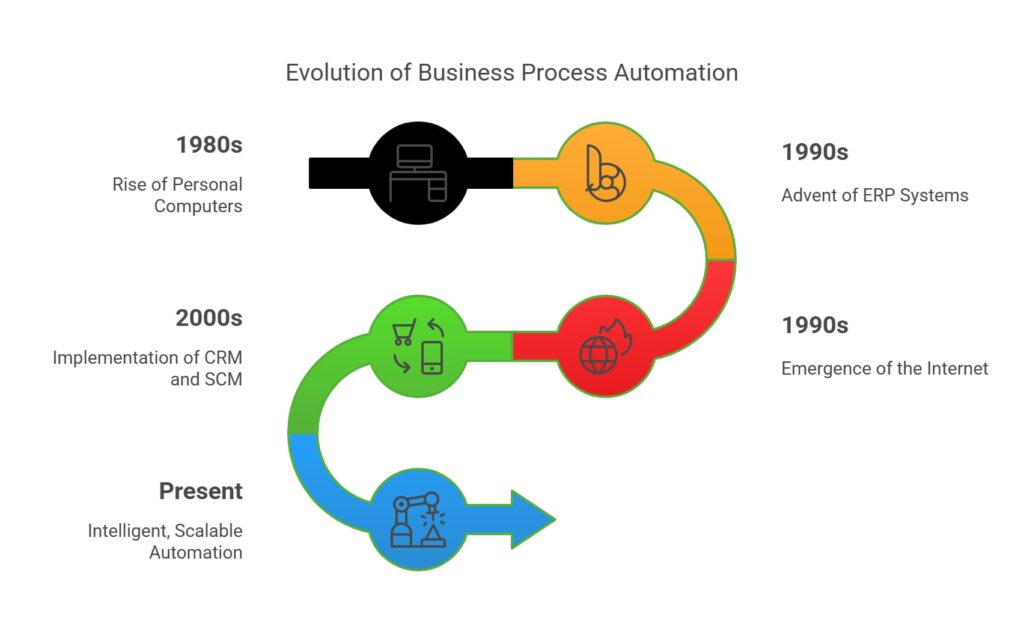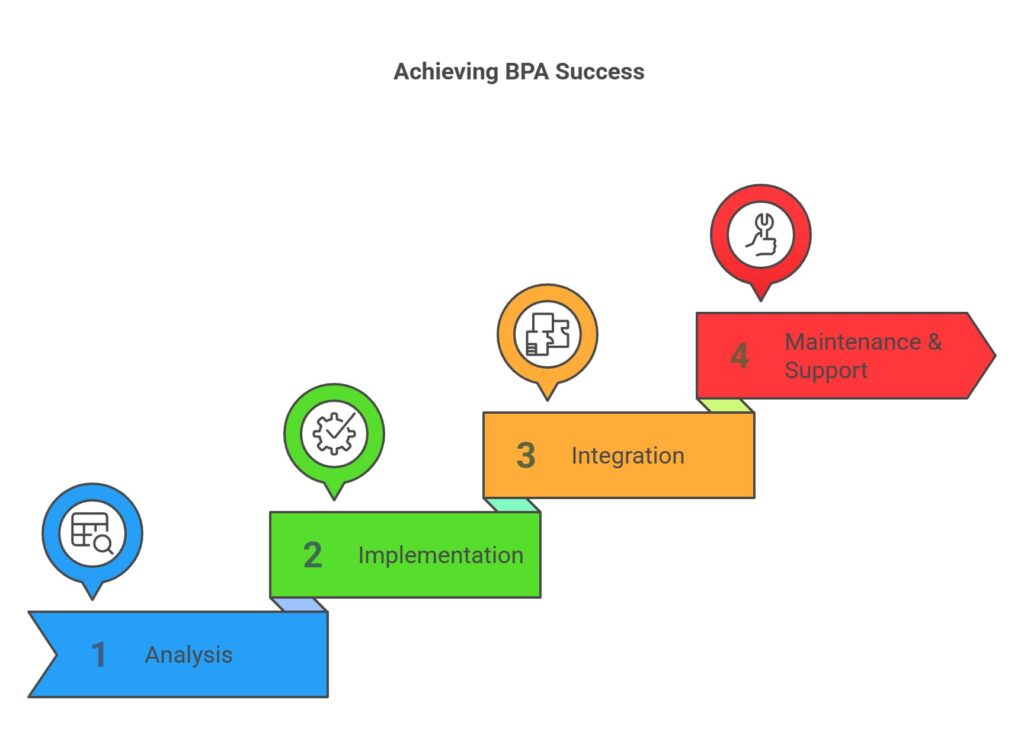Business Process Automation (BPA) has fundamentally transformed how organizations function—evolving from human-driven tasks to intelligent systems that operate with minimal oversight. This shift didn’t happen overnight. It unfolded over decades, shaped by technological advancements, operational complexities, and the relentless drive for efficiency.
Today, BPA isn’t just a helpful tool—it’s a strategic necessity for staying competitive in a digital-first world.
Let’s explore how we got here—and what lies ahead in the journey from manual to autonomous automation.
The Early Days: Manual Processes
Before the age of technology, businesses were almost entirely dependent on human labour. Tasks like bookkeeping, data entry, and inventory management were done manually, often using paper files and physical registers. These processes were slow, prone to error, and difficult to scale.
The Industrial Revolution was the first actual step toward automation. Factory floors saw the introduction of machinery run by steam, which began replacing manual labour. Though productivity improved, these machines still needed constant human intervention. It was the initial vision of tools augmenting human efficiency.
The Digital Spark: Early Computing (1950s–1970s)
The introduction of mainframe computers in the 1950s opened new opportunities for business. These massive machines, while expensive and bulky, could process large volumes of data far faster than humans.
They were applied chiefly to repetitive data-processing tasks such as payroll, billing, and inventory management. While narrow in scope, early computing laid the digital groundwork for what would eventually become modern-day BPA.
The Software Boom: 1980s–1990s
In the 1980s, the rise of personal computers revolutionized the workplace. Software applications enabled businesses of all sizes to automate mundane tasks such as word processing, financial reporting, and communication.
A milestone during this era was the emergence of Enterprise Resource Planning (ERP) systems, which integrated various departments—finance, HR, procurement—into a single digital platform. This eliminated duplication and enhanced data accuracy, enabling more strategic decision-making.
The Internet Era: 1990s–2000s
The advent of the internet ushered in a new generation of automation. Real-time communication, cloud storage, and web-based applications enabled businesses to scale globally.
Systems like Customer Relationship Management (CRM) and Supply Chain Management (SCM) emerged, streamlining customer engagement and logistics. Businesses could now operate 24/7 across borders, with information flowing seamlessly.
The Present: Intelligent, Scalable Automation
Today, BPA is intelligent, scalable, and intuitive. It’s not just about reducing manual work—it’s about creating smart workflows that continuously improve.
- Robotic Process Automation (RPA) uses software bots to execute repetitive tasks like invoice processing and report generation—error-free and around the clock.
- AI and Machine Learning (ML) enable systems to analyze data, identify trends, and make decisions. From AI chatbots to fraud detection, these technologies are redefining work.
- Low-code/no-code platforms empower even non-technical users to create automated solutions through visual builders.
- Cloud computing ensures that BPA tools are easily accessible, secure, and regularly updated.
- With big data and analytics, businesses can drive data-informed decision-making at scale.

Impact in the Real World
A 2022 McKinsey survey indicated that nearly 25% of business capital expenditure in the next five years would be directed toward automation technologies. Leading sectors include retail, food & beverage, and automotive.
BPA eliminates process bottlenecks, boosts productivity, and frees workers to focus on innovation and customer experience. The result? Faster delivery, better accuracy, and enhanced performance.
The Four Phases of BPA Success
Implementing BPA effectively requires a structured approach. Here are four essential phases:
-
Analysis
Identify inefficiencies. Map workflows, locate bottlenecks, and target processes that benefit most from automation. -
Implementation
Choose appropriate BPA tools, tailor them to your needs, and train teams. Pilot testing helps ensure smoother rollout. -
Integration
Seamlessly connect BPA tools with existing systems like ERP, CRM, and HR. Use APIs and integration platforms to eliminate data silos. -
Maintenance & Support
BPA systems require continuous monitoring and updates. Tools like process intelligence can help detect inefficiencies and recommend improvements.
The Future: Toward Full Autonomy
The next frontier is autonomous automation—where systems can learn, adapt, and act without human instruction.

Key Trends Driving the Future:
- Hyperautomation: Combines RPA, AI, and analytics to automate entire processes—not just tasks.
- Intelligent Process Automation (IPA): Can interpret unstructured data like emails and scanned documents.
- Digital Workers: Bots that operate alongside humans, handling repetitive work.
- Blockchain & Smart Contracts: Enable secure, automated transactions across finance, legal, and logistics.
- IoT Integration: Connects devices to BPA systems for real-time decision-making and predictive analytics.
Automation Across Industries
Manufacturing
Smart factories leverage IoT and AI for predictive maintenance, real-time monitoring, and process optimization.
Healthcare
Automation helps hospitals manage patient scheduling, assist in diagnoses, and maintain secure EHR systems.
Finance
Banks use AI to automate compliance, fraud detection, and risk management.
Retail & eCommerce
Technologies like AI chatbots, inventory automation, and personalized product recommendations enhance CX and efficiency.
The Human Side of Automation
While automation raises concerns about job displacement, the reality is role transformation. Machines handle the repetitive—humans focus on strategic, creative tasks.
The shift demands reskilling and upskilling. A hybrid workforce—where digital and human workers collaborate—is emerging as the new norm.
Ethical and Regulatory Considerations
As automation becomes ubiquitous, ethical and legal compliance is critical:
- Address job displacement with proactive workforce development.
- Guard against AI bias with transparent data and ethical training.
- Ensure compliance with privacy laws like GDPR and HIPAA.
- Push for global standards in automation ethics and governance.
The Road Ahead
From steam engines to self-learning systems, BPA has evolved from a basic efficiency tool to a driver of innovation and transformation.
The future is autonomous. Companies that adapt early will gain advantages in agility, performance, and resilience. Those that don’t will be left behind.
As we move forward, BPA will not just support business—it will define it.
